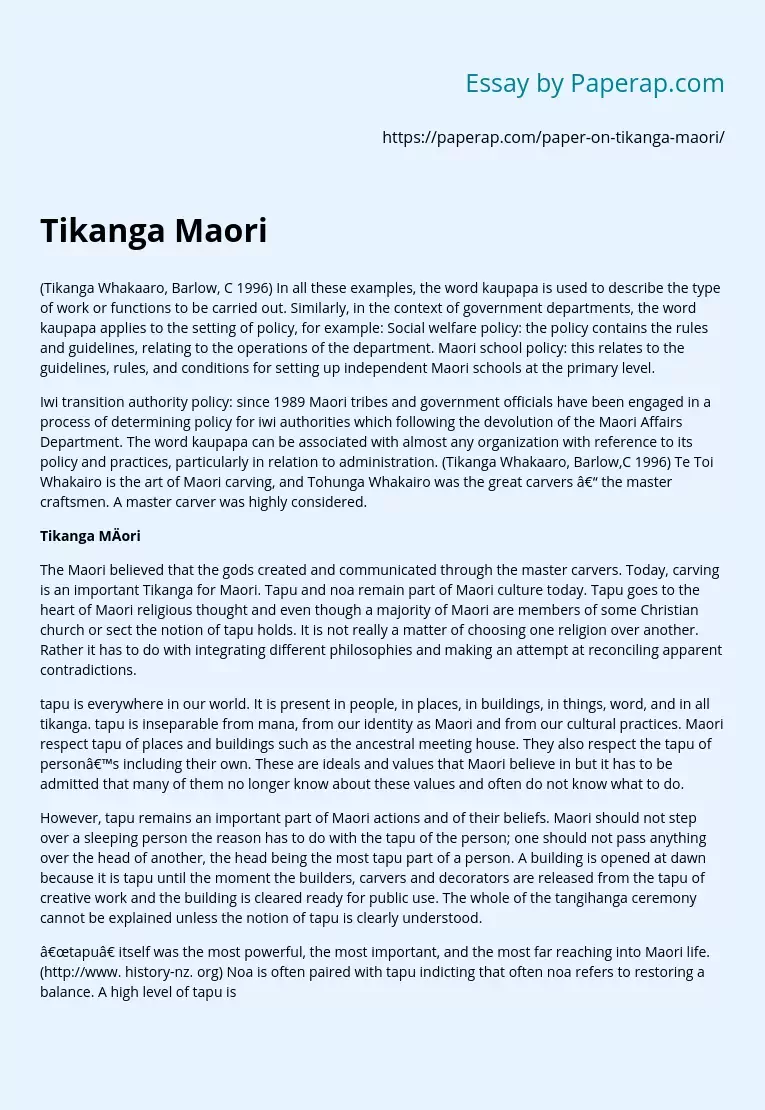Kaupapa and Functions.
(Tikanga Whakaaro, Barlow, C 1996) In all these examples, the word kaupapa is used to describe the type of work or functions to be carried out. Similarly, in the context of government departments, the word kaupapa applies to the setting of policy, for example: Social welfare policy: the policy contains the rules and guidelines, relating to the operations of the department. Maori school policy: this relates to the guidelines, rules, and conditions for setting up independent Maori schools at the primary level.
Iwi transition authority policy: since 1989 Maori tribes and government officials have been engaged in a process of determining policy for iwi authorities which following the devolution of the Maori Affairs Department. The word kaupapa can be associated with almost any organization with reference to its policy and practices, particularly in relation to administration. (Tikanga Whakaaro, Barlow,C 1996) Te Toi Whakairo is the art of Maori carving, and Tohunga Whakairo was the great carvers – the master craftsmen. A master carver was highly considered.
Tikanga Māori
The Maori believed that the gods created and communicated through the master carvers. Today, carving is an important Tikanga for Maori. Tapu and noa remain part of Maori culture today. Tapu goes to the heart of Maori religious thought and even though a majority of Maori are members of some Christian church or sect the notion of tapu holds. It is not really a matter of choosing one religion over another. Rather it has to do with integrating different philosophies and making an attempt at reconciling apparent contradictions.
tapu is everywhere in our world. It is present in people, in places, in buildings, in things, word, and in all tikanga. tapu is inseparable from mana, from our identity as Maori and from our cultural practices. Maori respect tapu of places and buildings such as the ancestral meeting house. They also respect the tapu of person’s including their own. These are ideals and values that Maori believe in but it has to be admitted that many of them no longer know about these values and often do not know what to do.
However, tapu remains an important part of Maori actions and of their beliefs. Maori should not step over a sleeping person the reason has to do with the tapu of the person; one should not pass anything over the head of another, the head being the most tapu part of a person. A building is opened at dawn because it is tapu until the moment the builders, carvers and decorators are released from the tapu of creative work and the building is cleared ready for public use. The whole of the tangihanga ceremony cannot be explained unless the notion of tapu is clearly understood.
“tapu” itself was the most powerful, the most important, and the most far reaching into Maori life. (http://www. history-nz. org) Noa is often paired with tapu indicting that often noa refers to restoring a balance. A high level of tapu is regarded as dangerous. Here the role of tikanga and of tohunga is reducing the level of endogenous tapu until it is noa or safe. It is not useful to think of noa as being the opposite of tapu or as absence of tapu. This is plainly not the case. For example a person can be very tapu if one is very ill of there is bleeding and shedding of blood.
Once these tapu-increasing symptoms have passed the person returns to a safe state, but still has personal tapu . the state of noa indicates that a balance has been reached, a crisis is over, health is restored and life is normal again. This means relationships are restored. This state coincides with a state of ea and noa. This state might last for several weeks until upset by some unexpected event. (http://www. history-nz. org) Tapu and noa remain part of Maori culture today, although persons today are not subject to the same tapu as that of previous times.
A new house today, for example, may have a “noa” ceremony to remove the “tapu”, in order to make the home safe before the family moves in. Nowadays, tapu absolutely are still in evidence concerning sickness, death, and burial. Tapu is evident in the Marae and in the Whare as well. The original reasons for some “tapu” are unclear today, but other reasons for “tapu” included the conservation of natural environment. This was seen to benefit the community as a whole. (http://www. history-nz. org)
In conclusion, this report shows the values, beliefs and ethics that underpin traditional Maori society and make relevance of literature about kaupapa Maori and tikanga Maori, analysis relevant philosophical and culture term of traditional Maori society and culture.
Bibliography The world wide web of Maori Organizations of New Zealand http://tikanga. maori. org. nz/ The main Maori Site on the Net. Barlow,C(1996)Tikanga Whakaaro: Key concepts in Maori Culture, Oxford University Press, Auckland.
Kaupapa and Functions.. (2019, Dec 05). Retrieved from https://paperap.com/paper-on-tikanga-maori/

